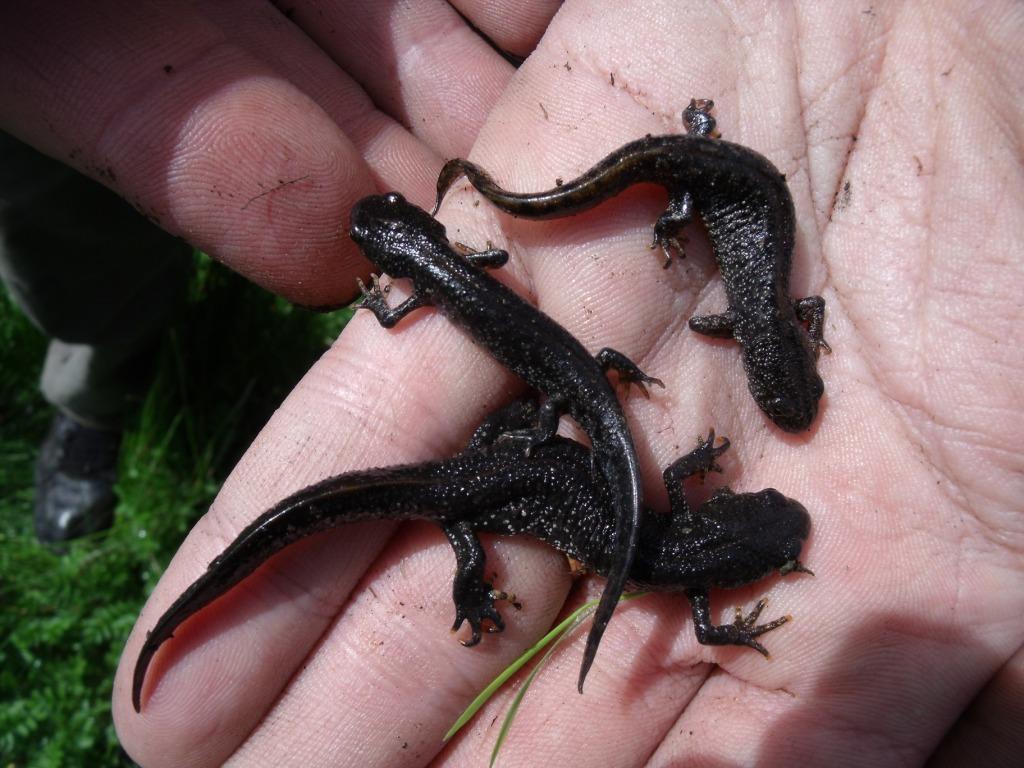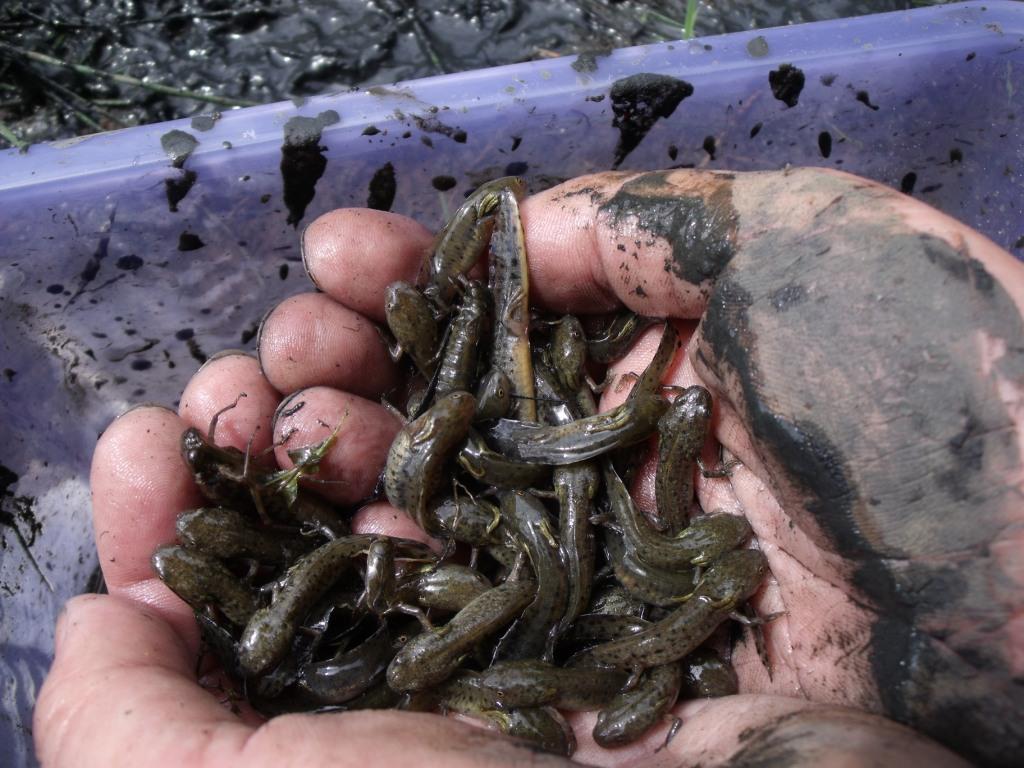 |
 |
metamorphosis times: |
| Author | Message |
|
will Senior Member Joined: 27 Feb 2007 No. of posts: 330 View other posts by will |
Posted: 04 Aug 2008 Hello All With supposedly drier summers compensated for by earlier egg laying in GCN I was wondering whether anyone has noticed earlier metamorphosis times for GCN in their patches ? I used to reckon on the beginning of Sept as being peak time for GCN newtlets to appear but at one London site on Sunday August 3rd I turned over a log to find the animals in the photo, including the 3 metamorphs you can see. What's the earliest date you have for emergence and when do you reckon the bulk of the population has left the water ? Cheers Will |
|
Vicar Senior Member Joined: 02 Sep 2004 No. of posts: 1181 View other posts by Vicar |
Posted: 05 Aug 2008 That's a cracking picture Will !  Could we use it on the SARG GCN webpage ? (credited of course!) I'm the worst person to ask, not really being a Pond-hugger...but, on Saturday night, at a local pond, there were dozens of meta-sized GCN in aquatic phase, all sporting gills, showing no sign of metaphorphosis, with the exception of one animal which was about ready to leave the water. I imagine that there is a wide distribution concerning the timing of metamorphosis, presumably you found some early leavers? Steve Langham - Chairman 
Surrey Amphibian & Reptile Group (SARG). |
|
will Senior Member Joined: 27 Feb 2007 No. of posts: 330 View other posts by will |
Posted: 05 Aug 2008 Thanks Steve Sure you can use it - just send me a pm with the relevant email address to send the high res image to. I reckon about 5-10% of this London GCN population's larvae have now metamorphosed, but many hundreds of larvae in this site still fully gilled and no sign of the yellow stripe which runs along the bottom of the tail - indicative of imminent metamorphosis along with gill reduction. Cheers Will |
|
Caleb Forum Coordinator Joined: 17 Feb 2003 No. of posts: 448 View other posts by Caleb |
Posted: 06 Aug 2008 [QUOTE=will] no sign of the yellow stripe which runs along the bottom of the tail - indicative of imminent metamorphosis along with gill reduction. [/QUOTE] Another useful indication of imminent metamorphosis is whether the larva walks (rather than thrashing like a fish) when it's lifted out of the water. This was suggested in a BHS Bulletin article by Steve & Arnold Cooke, and applies equally to all UK newts. |
|
will Senior Member Joined: 27 Feb 2007 No. of posts: 330 View other posts by will |
Posted: 06 Aug 2008 Absolutely - good point ! |
|
will Senior Member Joined: 27 Feb 2007 No. of posts: 330 View other posts by will |
Posted: 13 Jul 2009 By way of a follow-up to this topic, I visisted the site above today and managed to catch 180 well grown larvae in about 10cm of water, and to transfer them to a permanent pond closeby (fish free). As expected at this time of year, they were well grown but generally not close to metamorphosis. I was therefore very surprised to find what appeared to be a newly metamophosed GCN along with two larger (presumably last year) newtlets under a bin liner close to the pond in question. This metamorph still had the characteristic gill stubs and light yellow belly which typify newly metamorphosed animals. I guess earlier metamorphosis times following on from early oviposition compensate for hotter summers, in which ponds will desiccate much earlier. Has anyone else got early metamorphosis in GCN yet ? (it parallels the early births in Zotooca noted elsewhere)   |
|
Kelly L Member Joined: 09 Apr 2010 No. of posts: 1 View other posts by Kelly L |
Posted: 09 Apr 2010 [QUOTE=will]Hello All With supposedly drier summers compensated for by earlier egg laying in GCN I was wondering whether anyone has noticed earlier metamorphosis times for GCN in their patches ? I used to reckon on the beginning of Sept as being peak time for GCN newtlets to appear but at one London site on Sunday August 3rd I turned over a log to find the animals in the photo, including the 3 metamorphs you can see. What's the earliest date you have for emergence and when do you reckon the bulk of the population has left the water ? Cheers Will [/QUOTE] Thank you for the post. Hi guys, Im a newbie. Nice to join this forum. |
|
will Senior Member Joined: 27 Feb 2007 No. of posts: 330 View other posts by will |
Posted: 14 Apr 2010 Hi Kelly welcome to the forum - and thanks for your thanks re the post! Will |
|
ben rigsby Senior Member Joined: 27 Apr 2010 No. of posts: 337 View other posts by ben rigsby |
Posted: 29 May 2010 wow! amazing pics folks! i dont know about earlier metamorphosis timings but i can tell you that for the LAST FEW YEARS ive had male cristatus show up, start to crest, defend "territories" etc as early as late NOVEMBER here in GLOS. egg-laying in TC commences many weeks before that of the other species (who arrive at the pond at the "normal" time). ben Diversity. |
|
will Senior Member Joined: 27 Feb 2007 No. of posts: 330 View other posts by will |
Posted: 21 Jul 2010 Here's some vaguely quantitative data based on the site mentioned above. As usual, the main GCN pond was about to dry out, being reduced to two 'sumps' which each had around 10cm of water in them. In order to avoid the imminent death of well grown larvae, they were removed to a nearby pond to complete their development. A total of 1,100 larvae were caught, ranging from 3 to 7cm in length, the majority being 4.5cm. Of these, about 100 were close to metamorphosis and were left in the sumps, to take their chances. Around the pond margins 20 metamorphs were found, indicating that at least a few per cent of larvae had already metamorphosed, in spite of the late spring. Guess it goes to show that some 'catch up' is possible given warm late spring and early summer weather. Several years of larval rescues have led to torchlight counts of around 100 adults, which is pretty good for London crested newt populations. Here's a photo of a metamorph with its dried out pond behind it: |
- metamorphosis times |